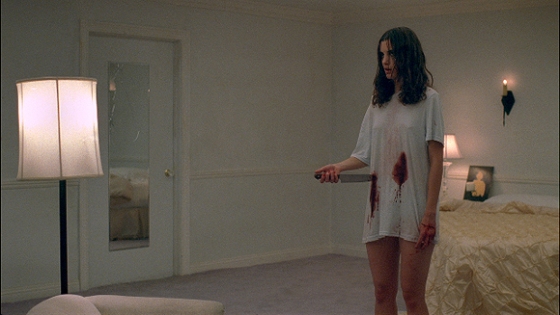
Below is a text I wrote for Nitehawk on women in horror film in conjunction with the film program, Final Girl…
“No live organism can continue for long to exist sanely under conditions of absolute reality.” ― Shirley Jackson, The Haunting of Hill House
Nitehawk’s Final Girl program celebrates fifty years of women in horror film by highlighting the iconic Final Girl. From Georges Franju’s depiction of beauty obsession in Eyes Without a Face (1960) to Adam Wingard’s role-reversing You’re Next (2011), this series focuses on the depiction of the woman’s role within the fictional realm of horror cinema and its association with the reality of daily life. The series eschews the popular bimbo slasher film stereotype by highlighting iconic female characters who experience a revelatory journey from victim to hero. Her on-screen transformation is hardly ever pretty, brutal by sheer necessity, but it realizes an important power shift: the stereotypical male gaze turns into her gaze and then to ours. Embodying Shirley Jackson’s description of Hill House, the Final Girl’s insane break from an “absolute reality” means that it is up to her, our heroine, to restore order when the familiar world becomes an overwhelming space.
When horror films are in top form they provide an incredible cultural analysis. Historically they’ve dealt with socio-political issues, from racism to capitalism, but gender norms have always been a constant. By addressing the patriarchal culture we live in, horror tells us what the possibilities for change are and, in its own visceral way, adjusts the imbalance. This marriage of women and horror actually traces back to 18th century Gothic novels like The Castle of Otranto and the genre has carried on the tradition all the way up to the self-reflexive postmodern heyday of the 1970s-90s. Because horror has the uncanny ability to simultaneously embrace and explode stereotypes when tackling women’s roles, it reveals a victim-to-survivor figure by depicting the “weaker” sex in a position of power with far superior survival skills and intelligence. This is particularly true when they show the struggle and sublimation of women in/out of domesticity via the haunted or evil house; it’s one constant that pops up in horror films and is the commonality amongst all of the films in our Final Girl series.
The concept of the ‘Final Girl’ put forth by scholar Carol Clover in her book Men, Women, and Chain Saws: Gender in the Modern Horror Film applies directly to Shirley Jackson’s above description of the inherently evil atmosphere that permeates her novel The Haunting of Hill House written more than thirty years earlier. The extreme pressure of coping with an unreal horror that becomes the Final Girl’s reality is a commonality shared amongst many, if not most, cinematic horror heroines and it is an essential part of actually being a true Final Girl. This woman, according to Clover, is the person with whom the audience (regardless of gender) identifies with most because we share in her experience and desire for survival in the very strange land she’s found herself in. And ever since she emerged from the Italian giallo and subsequent American slasher movies of the 1970s and 80s, this Final Girl has become a reliable fixture within horror narratives. That is, of course, until post-post modern horror film tackled our comfortable associations with her head on. Regardless, whether she’s the lone survivor amongst her dead companions or the sacrificial lamb to the monster, the historic representation of women in horror is culturally significant. The two appear to be inextricably bound together.


